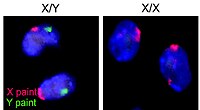
Back Gameet Afrikaans Gamet ALS جاميت (أحياء) Arabic جاميت ARZ Qamet Azerbaijani Гамета Bashkir Гамета Byelorussian Гамэта BE-X-OLD Гамета Bulgarian জননকোষ Bengali/Bangla
| Part of a series on |
| Sex |
|---|
 |
| Biological terms |
| Sexual reproduction |
| Sexuality |
| Sexual system |
A gamete (/ˈɡæmiːt/; from Ancient Greek γαμετή (gametḗ) 'wife', ultimately from Ancient Greek γάμος (gámos) 'marriage') is a haploid cell that fuses with another haploid cell during fertilization in organisms that reproduce sexually.[1] Gametes are an organism's reproductive cells, also referred to as sex cells.[2] The name gamete was introduced by the German cytologist Eduard Strasburger in 1878.[3]
Gametes of both mating individuals can be the same size and shape, a condition known as isogamy. By contrast, in the majority of species, the gametes are of different sizes, a condition known as anisogamy or heterogamy that applies to humans and other mammals. The human ovum has approximately 100,000 times the volume of a single human sperm cell. The type of gamete an organism produces determines its sex[4] and sets the basis for the sexual roles and sexual selection.[5] In humans and other species that produce two morphologically distinct types of gametes, and in which each individual produces only one type, a female is any individual that produces the larger type of gamete called an ovum, and a male produces the smaller type, called a sperm cell or spermatozoon. Sperm cells are small and motile due to the presence of a tail-shaped structure, the flagellum, that provides propulsion. In contrast, each egg cell or ovum is relatively large and non-motile.[2]
Oogenesis, the process of female gamete formation in animals, involves meiosis (including meiotic recombination) of a diploid primary oocyte to produce a haploid ovum. Spermatogenesis, the process of male gamete formation in animals, involves meiosis in a diploid primary spermatocyte to produce haploid spermatozoa. In animals, ova are produced in the ovaries of females and sperm develop in the testes of males. During fertilization, a spermatozoon and an ovum, each carrying half of the genetic information of an individual, unite to form a zygote that develops into a new diploid organism.[2]
- ^ "gamete | Definition, Formation, Examples, & Facts". Encyclopedia Britannica. Retrieved 20 October 2020.
- ^ a b c "gamete / gametes | Learn Science at Scitable". www.nature.com. Retrieved 20 October 2020.
- ^ "gamete | Etymology of gamete by etymonline". www.etymonline.com. Retrieved 6 June 2024.
- ^ Cotner S, Wassenberg D, "8.4 Sex: It's About the Gametes", The Evolution and Biology of Sex, retrieved 20 October 2020
- ^ Fusco G, Minelli A (10 October 2019). The Biology of Reproduction. Cambridge University Press. pp. 111–112. ISBN 978-1-108-49985-9.